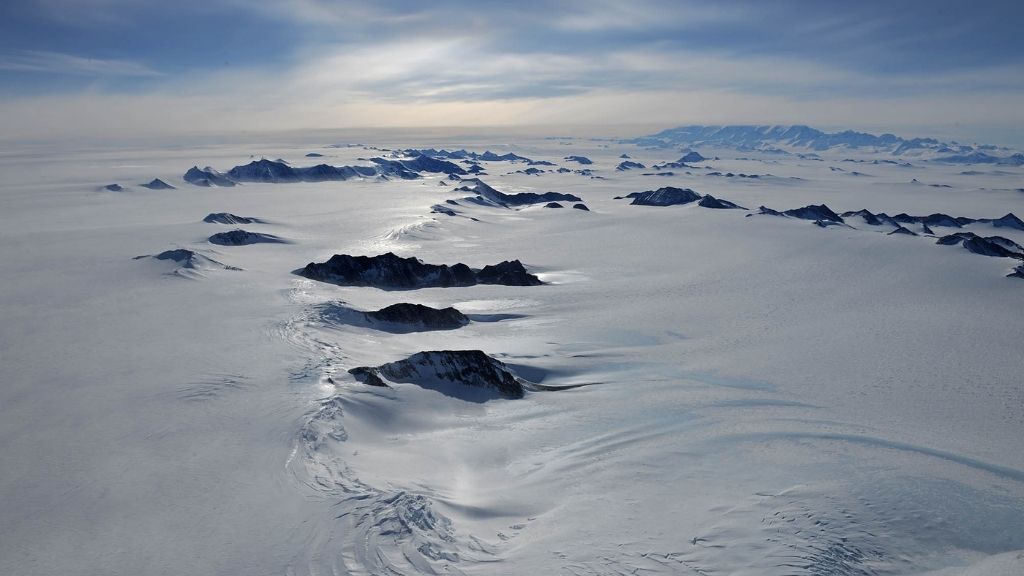Lakes beneath the Antarctic ice could be teeming with microbial life

Frigid lakes locked beneath the Antarctic ice sheet may be home to more microbial life than scientists ever imagined.
More than 400 subglacial lakes lie beneath the Antarctic ice sheet, completely shut off from sunlight, according to the new paper, published Feb. 17 in the journal Science Advances. These lakes form where the weight of the surface ice bears down on the base of the sheet, generating intense pressure and lowering the melting point of the ice. As the base melts, the remaining ice insulates the meltwater from cold air, while geothermal heat from the bedrock below also helps prevent freezing, according to a statement.
Some of these pitch-black lakes lie near the ice sheet's edge, where water can periodically flow in and out. Scientists have uncovered microbial life in two of these hydrologically active lakes, but it's unknown whether more isolated lakes near the center of the ice sheet can also sustain life. Many of these lakes have been cut off from the surrounding environment for millions of years.
Related: Antarctica: The ice-covered bottom of the world (Photos)
Past research suggested that microorganisms in these forbidding lakes likely live in the sediment at the lake bottom, which is brimming with nutritious minerals, a 2018 study in the journal Earth and Planetary Science Letters found. But now, the new study hints that microbes may thrive throughout the extreme ecosystem, in both the sediment and the surrounding water.
Geothermal heat flux — the flow of heat from the Earth's interior — essentially stirs the lake water, lifting nutrients from the sediment into the water above, the study suggests.
"The water in lakes isolated under the Antarctic ice sheet for millions of years is not still and motionless; the flow of water is actually quite dynamic," lead author Louis-Alexandre Couston, a physicist at the University of Lyon in France and the British Antarctic Survey, said in the statement. "With dynamic flow of water, the entire body of water may be habitable."
Sign up for the Live Science daily newsletter now
Get the world’s most fascinating discoveries delivered straight to your inbox.
In above-ground lakes, water flows due to wind and heat from the sun. This powers convection currents, where differences in water temperature across the lake drive water flow. Although subglacial lakes can't be warmed by the sun, the team determined that heat from the planet's interior is strong enough to fuel "vigorous" convection currents from below. The heat itself is generated by the decay of radioactive elements, such as thorium and uranium, and also includes heat left over from when Earth first formed, according to a 1990 report in the journal Geophysics.
As heat causes the subglacial water to circulate, this flow not only frees minerals from the sediment, but also distributes oxygen and minerals from higher in the water column; these additional nutrients come from dust trapped in the ice sheet that gets released as the ice melts.
Related: Ocean sounds: The 8 weirdest noises of the Antarctic
"Our calculations demonstrate that mixing of subglacial lake water is highly likely and would encourage dispersion of oxygen-rich water throughout the water column and down to the lake floor sediments, where microbial life is likely to be most abundant," the authors wrote in the new study.
The team based these initial conclusions on modeling studies, but soon, scientists plan to sample water and sediment from a subglacial lake called Lake CECs, named after the Chilean scientific center Centro de Estudios Científicos, according to the statement. This expedition will allow the team to test their predictions and see where microbes actually live in the unique ecosystem.
For now, based on their current modeling, "it should be considered that most — if not all — Antarctic subglacial lakes are dynamic hydrologic environments," the authors wrote. "We expect that the same conclusion holds for isolated subglacial lakes in Greenland and elsewhere in the solar system," in reference to subglacial lakes on the moons of Jupiter and Saturn, they added.
"The physics of subglacial water pockets is similar on Earth and icy moons, but the geophysical setting is quite different," meaning the physical properties of the surrounding environment, study author Martin Siegert, co-director of the Grantham Institute – Climate Change and Environment at Imperial College London, said in the statement. So while both environments are similar, new theories will be needed to understand what additional physical factors might shape subglacial lakes on icy moons, Siegart said.
"With new missions targeting icy moons and increasing computing capabilities, it's a great time for astrobiology and the search for life beyond the Earth," he said.
Originally published on Live Science.

Nicoletta Lanese is the health channel editor at Live Science and was previously a news editor and staff writer at the site. She holds a graduate certificate in science communication from UC Santa Cruz and degrees in neuroscience and dance from the University of Florida. Her work has appeared in The Scientist, Science News, the Mercury News, Mongabay and Stanford Medicine Magazine, among other outlets. Based in NYC, she also remains heavily involved in dance and performs in local choreographers' work.









